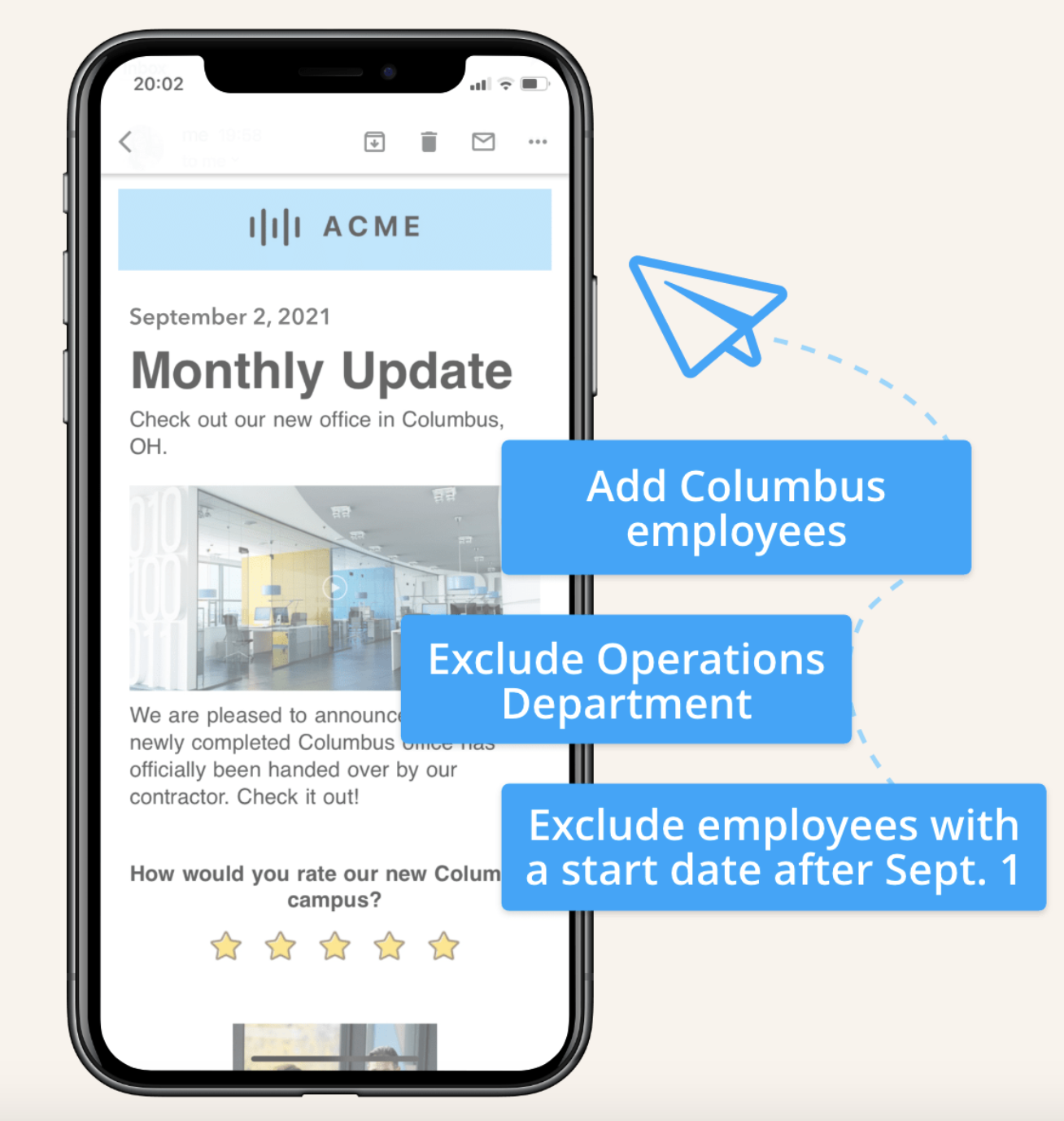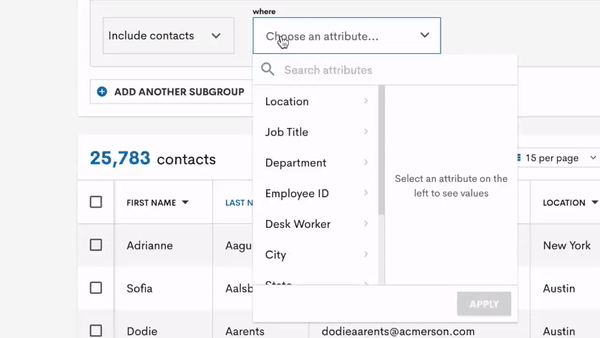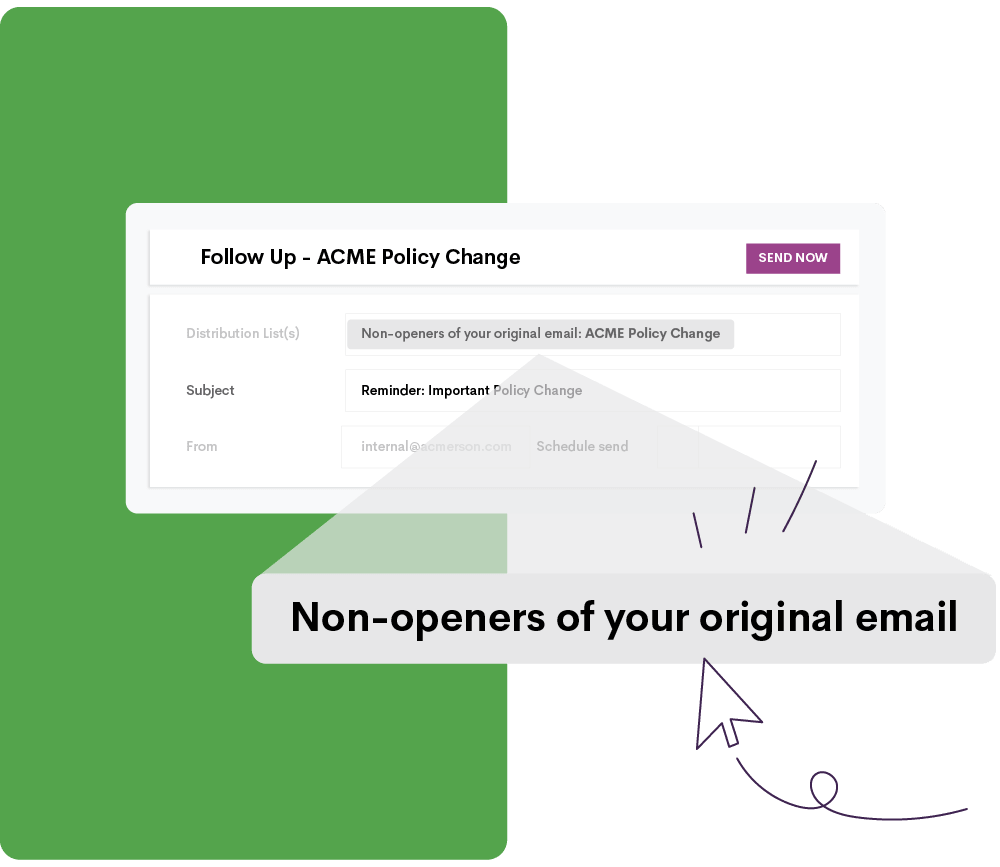Sending all-staff emails certainly has its advantages.
First, you know that everyone will receive your message because it’s addressed to absolutely everyone. (Whether they will read them or not is another story.)
Second, the distribution list is usually maintained by IT so you don’t really have to worry about it being up to date or missing anyone.
And of course, if you’re sending to everyone, you don’t have to send multiple copies of the same email.
Overall, it’s easy and convenient.
So the question remains: why then do all-staff emails have such a bad rap?
Why all-staff emails are problematic
Aside from the stressful situations that can arise from an all-staff email gone awry, studies show that employees are inundated and overwhelmed by email.
Every message splits their attention and reduces the time they have to do their actual work.

Besides stressing out employees and distracting them from their work, sending all-staff emails too often—or making all of your internal emails all-staff—will inevitably dilute the effectiveness of your email channel.
It’s simple math: the more messages employees receive, the less important they each seem and the more overloaded employees feel.
Of course, there are times when an all-staff email might be absolutely necessary, but those instances are becoming rarer and rarer. Especially with dispersed offices across countries and continents, and more employees working remotely.
What once would have been an effective email strategy because most employees were located in the same place, had the same concerns, spoke in the same language, and needed the same information, is now becoming obsolete.
All employees don’t have the same information and communication needs. So treating all employees the same when it comes to your email channel is likely to become ineffective quickly—if it hasn’t already damaged the reputation of your channel.
If you’re serious about effective communication, providing employees with relevant, timely information, and creating a positive employee experience with your communication channels, you’re going to have to seriously reconsider your all-staff email strategy.
Which brings us to the question: what’s the most effective alternative to the dreaded all-staff email?
Meet employee email list segmentation
Marketers figured out the value of segmenting their email lists a long time ago.
They’ve been segmenting their mailing lists into smaller, targeted lists based on location, age, gender, interests, purchase history, and more. While tailoring unique messaging to each of these segments sounds like extra work, it's certainly effective.
According to our friends at Hubspot, "marketers who use segmented campaigns note as much as a 760% increase in revenue.”
Wowza.
Why you should segment your employee distribution lists
While you may not use your communications to generate revenue, you’d probably like to increase your open rates and make your communication campaigns as effective as possible.
Based on the data we’ve pulled from Staffbase, we’ve learned that internal communicators are able to increase their engagement rates by segmenting their distribution lists.
In practical terms, when employees are receiving tailored, relevant communications, they are more likely to open the email, read it, and click the links inside. This indicates that they are actually engaging with and digesting the content, rather than giving it a glance and dropping it in their trash folder.
And this information consumption and changed behavior are exactly what you want to see—it will help you show that your communication strategy is effective.

But what does this have to do with internal communications?
And can this same effectiveness be achieved by segmenting your employee distribution lists?
How should you segment your employee distribution lists?
So if we know that segmenting your employee email lists leads to higher engagement and more effective communications, the natural next step is to figure out which segments would be most effective for your employee population.
Depending on your organization, what your business and employees do, and what the culture of your organization is like, the kinds of employee email segments you build are going to vary.
But, we have to start somewhere, so to find some of the most effective employee email segments, we only need to look at what our friends in marketing are doing for a little inspiration.
We’ve seen communicators and marketers alike build segments based on categories like:
- Geographic location
- Division or department
- Corporate hierarchy (i.e. for people managers only)
We’ve also found that if you are communicating to over 1000 employees, you’ll likely have segments of your workforce that:
- Are not working in the same time zone
- Do not work normal office hours
- Don’t always have access to their emails
If you’re sending these employees all-staff emails, they’re even more likely to be overlooked or even missed completely. This also makes them great candidates for their own employee email segments that can be treated differently than other segments, in order to improve engagement.
As you can see, there are some natural, intuitive segments that already exist in your employee population that would benefit greatly from having an email strategy that is more tailored to their specific working conditions and unique needs.
And if you want to try out employee email distribution list segmentation, this is a great place to start.
The power of segmenting your employee distribution lists
Employee email segmentation solves a lot of issues folks have with all-staff emails, and email as a comms channel in general.
For one, segmentation can help you find the perfect time to send your communications for optimal open rates and engagement, based on that segment’s email behavior.
Sending an all-staff email to employees who are located across the globe, in various time zones means that for some folks, the email will be received in the middle of the night, perhaps buried under 100 other emails they have to get to in the morning.
Or it will arrive in their inbox at the end of the day when they just give it a quick glance but don’t have the energy to really get into it. Come the next morning, that email is buried and forgotten forever.
Again, there are many factors that will change the optimal time for sending important emails. It all depends on what your organization does, where your employees are located, and if they have access to their email during the day.
Segmenting your employee email lists acknowledges this reality and allows you to use it to the advantage of your communication strategy.
It also allows you to collect data on specific segments so that you’re not just sending on a hunch—you will have proof that specific segments are most engaged with your emails at certain times of the day, so you can tailor your strategy accordingly.
The more specific you make your segments, the more opportunity you have to make your communications relevant to that audience.
For example, employees in different regions or divisions will likely have different priorities in terms of the messages they would like to see. With smart employee email segmentation, you have the power to craft unique and relevant messaging for particular groups, like customer-facing employees or factory workers, so they actually provide value to the given group.

How easy is it to create segmented employee distribution lists?
Segmenting your employee email lists doesn't mean doubling or tripling the amount of work on your plate.
You don��’t have to create totally custom emails for every employee segment.
Segmentation is more about considering your audience, recognizing that all employees aren't the same, and tailoring your communications to improve the employee experience.
We’ve found that even small tweaks to your emails can make them much more impactful to different audiences, while also making the data you capture more meaningful.
That being said, if you’re not using a custom distribution list tool (like Staffbase offers) segmentation will be a challenge and could lead to a lot more work.
One reason is that unfortunately, communicators typically don’t control their own distribution lists.
If you’re stuck waiting on IT to update your existing all-staff or all-United-States list, segmentation won’t always be possible without losing your ability to be timely. And insisting IT be responsible for creating and maintaining additional sub-lists could be a big challenge.
Staffbase’s Custom Distribution Lists feature is designed to help communicators like you segment and take control of your distribution lists—without needing to rely on IT.

We want to give you the power to easily create your own distribution lists (in minutes), based on any attributes that are stored within your company’s directory.
We’ve also added the ability to send follow-up emails to only the employees who didn’t open your original email. This helps ensure that everyone is on the same page while avoiding inbox clutter for employees who’ve already opened your emails.

Pairing this powerful functionality with our drag-and-drop Email Designer that allows you to template your communications and quickly switch out content in just a few clicks, means that you’ll be able to send tailored communication to multiple segments in the same time or less time than it would take you to send one all-staff email using HTML and Outlook.
PS. If you’re interested in finding out more about how quick and easy the Email Designer makes creating tailored, on-brand employee emails, you can get started with a free demo right here.
Employee email list segmentation is the future
Employee email segmentation is the next step in the evolution in employee email as a channel.
We know this for a couple of reasons:
- Because internal communication trends reliably follow marketing trends (albeit 5 years later) and segmentation is essential to any good marketing strategy.
- Email is still—and will remain—a staple of communication in and out of the workplace. Because employees use email in their non-work life, their standards for communication in this channel will always be dictated by how they are being communicated to by brands as a consumer.
- Employee experience is coming to the forefront of organizational culture and a lot of that work to improve these experiences is already falling on internal communication departments.
So whether you decide to start implementing employee email list segmentation as part of your strategy now or not, it is inevitable that you’ll have to convert eventually.
But if that all feels intimidating to you and you’re still struggling with distribution lists for your internal email strategy as it is, you’re not alone.
Most communication professionals, unfortunately, are in the same boat.
The good news is that you’ve still got time to master segmentation and show your organization that you’re serious about increasing the effectiveness of your communications.
And we can help.
If you’d like to find out more about list segmentation best practices and how Staffbase is already helping communicators solve these struggles, click the button below and book a demo with our team.




